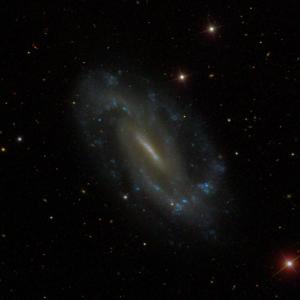The barred-spiral galaxy NGC 3319 spins through Ursa Major, the Great Bear. It's about 47 million light-years from Earth, and it's a little smaller than our home galaxy, the Milky Way. NGC 3319 may contain an intermediate-mass black hole -- one of only a few discovered to date. The black hole appears to be about 30,000 to 100,000 times the mass of the Sun. Hot gas spiraling into the black hole produces X-rays, which is how the possible black hole was discovered. [Sloan Digital Sky Survey]
You are here
NGC 3319
The astronomers who study black holes have a bit of a problem. They’ve discovered lots of black holes that are fairly small — up to a few dozen times the mass of the Sun. And they’ve discovered many others that are jumbo — millions or billions of times the mass of the Sun. But they’ve discovered few black holes between those sizes. It’s like finding a lot of chihuahuas and great Danes, but no terriers.
One possible mid-sized black hole is in the galaxy NGC 3319. It’s in Ursa Major, the great bear, which dips low across the northern sky on October evenings.
The galaxy is about 47 million light-years away — close as galaxies go. That makes it easy to study. Like our home galaxy, the Milky Way, it’s a barred spiral. It has a long, skinny bar of stars in the middle, with beautiful spiral arms trailing off the ends of the bar. It’s not quite as big as the Milky Way, and it’s fairly faint.
A few years ago, astronomers reported the discovery of an intermediate-mass black hole in the heart of the galaxy. A study this year said the black hole is about 30,000 to 100,000 times the mass of the Sun. By comparison, the black hole at the center of the Milky Way is more than four million times the Sun’s mass.
The possible black hole produces a lot of X-rays. The energy probably comes from super-hot gas falling into the black hole. But more astronomers need to confirm the discovery of this busy “terrier” among black holes.
Script by Damond Benningfield
Get Premium Audio
Listen to today's episode of StarDate on the web the same day it airs in high-quality streaming audio without any extra ads or announcements. Choose a $8 one-month pass, or listen every day for a year for just $30.




